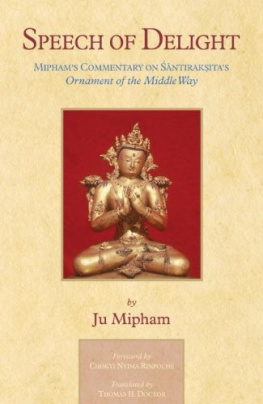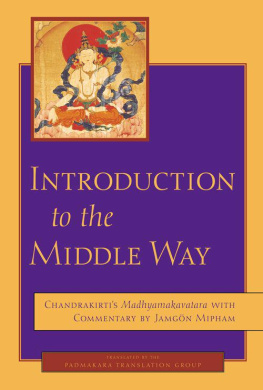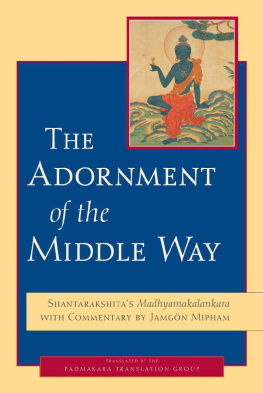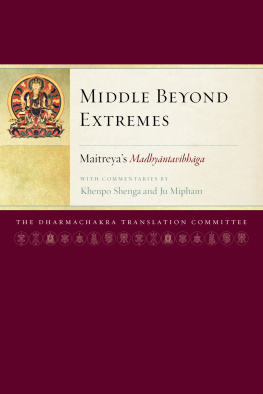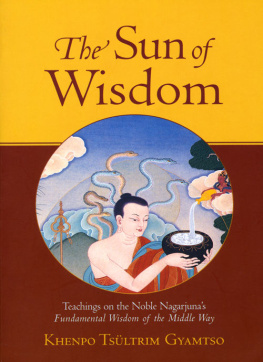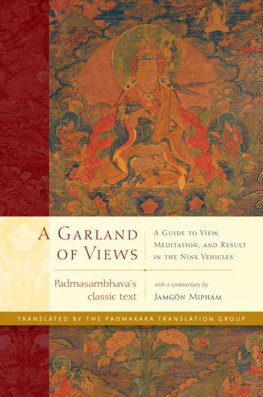by
Mipham Jamyang Namgyal Gyatso
Foreword by
CHOKYI NYIMA RINPOCHE
Translated by
THOMAS H. DOCTOR





.................................................................................... vii
............................................................. ix
.................................................. xvii
......................................................... xx
................ 3
................................................................................. 5
PART I
.............................................. 9
.............................. 11
PART 2
.................................................................. 147
.................................. 157
............................................ 419
............................................................... 483
............................................................. 583
...................................... 695
............................................................. 710
.......................................................................... 715
........................................................... 723
........................................................... 746
............................................................................... 764
.......................................................................................... 767

Sdkyamuni Buddha
L.
Chokyi Nyima Rinpoche
Our Teacher, the Buddha and Transcendent Conqueror, is like a great unknown friend to all us sentient beings. He is a master of inconceivable and inexpressible qualities, such as wakeful wisdom, loving compassion, enlightened activity, and the power that saves and protects. His authentic teachings are expressed in the three consecutive wheels of the Dharma. Within these teachings, the Ornament of the Middle Way is classified primarily as an explanation on the intent of the intermediate Dharma wheel, which directly reveals the abiding way of all objects of cognition and establishes the principles of emptiness. Its author, the great preceptor Santaraksita, was the founder of the Middle Way of Yogic Action and is repeatedly praised in prophesies in sutras and tantras of the Victorious One. He became indisputably renowned, like the sun and the moon, in both the Noble Land of India and in Tibet.
In his Ornament of the Middle Way, Santaraksita emphasizes the way to establish the unity of the two truths, which is the great indivisibility of appearance and emptiness, and thereby authentically elucidates the realization of the Victorious Lord of the Capable Ones. Due to the power of Santaraksita's cultivation of the enlightened mind, and through his aspirations, the Buddha's teachings were disseminated and established in the snowy land of Tibet. Composed by this kind master, the Ornament of the Middle Way is a perfect scripture of extreme profundity.
The Lord of Speech in the Land of Snow, the king of all who have gained expertise and accomplishment, the all-seeing mahapandita Mipham Jamyang Namgyal Gyatso, saw many special reasons for writing a commentary on the Ornament of the Middle Way and so composed this perfect tika. Intended for those who pursue a knowledge that is both profound and vast, this commentary is given in a style that is concise and lucid. Profound and vast in meaning, it conveys the heart practice of all accomplished knowledge-holders and reveals the single path traversed to omniscience. Containing key-points and oral instructions for all philosophies, it is like a single bridge that spans a hundred rivers.
This commentary has now been rendered into English by my direct disciple, Thomas Doctor, also known by his Dharma name, Lungtog Sangpo, who has unchanging faith and trust in the Buddhadharma. Rejoicing from my heart in this fact, I offer benedictions and prayers that the genuine tradition of the Victorious Lion of the Sakyas may be present throughout all corners of the world as the source of happiness and joy for the benefit of the teachings and sentient beings.
This was written by Chokyi Nyima, who bears the name ofTulku, on the auspicious 10`h day of the waxing second moon in the male water horse year, the year 2129 of the Tibetan kings.

The Madhyamakalamkara (hereafter MA) of Santaraksita (8t' century c.E.) is renowned as the principal scripture of the Yogacaramadhyamaka.' Although masters such as Arya Vimuktisena2 (6`h century c.E.) are said to have set forth their presentations of the Madhyamaka in a way that employs the assertions specific to the Vijnanavada, Santaraksita was the one to found an actual system in which the ultimate freedom from constructs (Skt. nis- prapanca, Tib. spros bral) is realized through insight into the non-existence of any external matter (bahyartha, phyi don).' This synthesis of Yogacara and Madhyamaka, the two great currents of Mahayana philosophy, the principles of the vast and the profound as originally set forth by Asanga (fl. 4`h century) and Nagarjuna (possibly 150-250 c.E.) respectively, is also characterized by its use of the pramana methods of Dignaga (5th-6`h century) and Dharmakirti (6`h-7`h century) as integral steps towards the realization of the ultimate. The school was further propagated in India and Tibet by Santaraksita's chief disciple, Kamalaila, and in Tibet it seems to have been universally recognized as an unsurpassable Madhyamaka presentation until at least the twelfth century.4 With the later practice of distinguishing Madhyamaka philosophy chiefly in terms of Thai 'gyur ba/Prasangika and Rang rgyud pa/Svatantrika5 and asserting the Prasangika to be, almost by definition, the supreme view' the school's influence became less evident. Hence, as the Madhyamakavatara of Candrakirti (7h century) (in which the ultimate establishment of key principles in Vijnanavadin philosophy is refuted at length) gained increasing authority, it became less of an obvious choice to found one's presentation on the existence of such as the all-ground (alaya, kun gzhi)-even if that existence was only in terms of the conventional (vyavahara, tha snyad).

